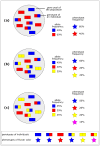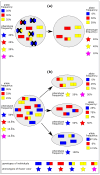Transition Processes in Technological Systems: Inspiration from Processes in Biological Evolution
- PMID: 40558375
- PMCID: PMC12190928
- DOI: 10.3390/biomimetics10060406
Transition Processes in Technological Systems: Inspiration from Processes in Biological Evolution
Abstract
With environmental challenges intensifying, a fundamental understanding and sustainable management of ongoing transition processes are crucial. Biological evolution provides valuable lessons on how to adapt and thrive under changing conditions. By studying its key principles, we identified analogies between biological evolution and technological transitions in terms of both the Multi-Level Perceptive and the path dependency model. The comparative study also revealed that, despite contrasting time scales, the generation-based and version-based developments are comparable. In addition, interesting similarities were found in the increase and decrease of variety and between fitness and consistency. The lessons learned from biology include "Give it a try", "Do not close for reconstruction", and "Keep older versions in the innovation process". Based on this comparison, we aim to gain insights for a better understanding of how to manage technology transitions and to derive concrete indicators for assessing and monitoring them. In doing so, we can provide action-oriented guidance for developing more sustainable technological solutions for major ongoing transitions, such as the energy transition.
Keywords: MLP (Multi-Level Perspective); energy transition; exnovation; fitness; generation; innovation; niche; path dependency; population; selection.
Conflict of interest statement
Author Martin Möller was employed by the company Öko-Institut Consult GmbH. The remaining authors declare that the research was conducted in the absence of any commercial or financial relationships that could be construed as a potential conflict of interest.
Figures







Similar articles
-
Systemic pharmacological treatments for chronic plaque psoriasis: a network meta-analysis.Cochrane Database Syst Rev. 2017 Dec 22;12(12):CD011535. doi: 10.1002/14651858.CD011535.pub2. Cochrane Database Syst Rev. 2017. Update in: Cochrane Database Syst Rev. 2020 Jan 9;1:CD011535. doi: 10.1002/14651858.CD011535.pub3. PMID: 29271481 Free PMC article. Updated.
-
Systemic pharmacological treatments for chronic plaque psoriasis: a network meta-analysis.Cochrane Database Syst Rev. 2021 Apr 19;4(4):CD011535. doi: 10.1002/14651858.CD011535.pub4. Cochrane Database Syst Rev. 2021. Update in: Cochrane Database Syst Rev. 2022 May 23;5:CD011535. doi: 10.1002/14651858.CD011535.pub5. PMID: 33871055 Free PMC article. Updated.
-
Signs and symptoms to determine if a patient presenting in primary care or hospital outpatient settings has COVID-19.Cochrane Database Syst Rev. 2022 May 20;5(5):CD013665. doi: 10.1002/14651858.CD013665.pub3. Cochrane Database Syst Rev. 2022. PMID: 35593186 Free PMC article.
-
Intensive case management for severe mental illness.Cochrane Database Syst Rev. 2010 Oct 6;(10):CD007906. doi: 10.1002/14651858.CD007906.pub2. Cochrane Database Syst Rev. 2010. Update in: Cochrane Database Syst Rev. 2017 Jan 06;1:CD007906. doi: 10.1002/14651858.CD007906.pub3. PMID: 20927766 Free PMC article. Updated.
-
Education support services for improving school engagement and academic performance of children and adolescents with a chronic health condition.Cochrane Database Syst Rev. 2023 Feb 8;2(2):CD011538. doi: 10.1002/14651858.CD011538.pub2. Cochrane Database Syst Rev. 2023. PMID: 36752365 Free PMC article.
References
-
- Olbrich S., Bauknecht D. The system building perspective for building sustainable system configurations using the German energy transition as an example. Oxford Open Energy. 2024;3:oiae010. doi: 10.1093/ooenergy/oiae010. - DOI
-
- European Environment Agency Europe’s Sustainability Transitions Outlook: Short-Term Action, Long-Term Thinking. 2024. [(accessed on 20 March 2025)]. Available online: https://www.eea.europa.eu/en/analysis/publications/europes-sustainabilit....
-
- Luu R.K., Arevalo S., Lu W., Ni B., Yang Z., Shen S.C., Berkovich J., Hsu Y.C., Zan S., Buehler M.J. Learning from nature to achieve material sustainability: Generative AI for rigorous bio-inspired materials design. MIT Explor. Gener. AI. 2024 doi: 10.21428/e4baedd9.33bd7449. - DOI
-
- Möller M., Höfele P., Kiesel A., Speck O. Reactions of sciences to the Anthropocene: Highlighting inter- and transdisciplinary practices in biomimetics and sustainability research. Elem. Sci. Anthr. 2021;9:035. doi: 10.1525/elementa.2021.035. - DOI
-
- Brundtland Commission . Our Common Future: Report of the World Commission on Environment and Development. Volume 10 Oxford University Press; Oxford, UK: 1987.
Grants and funding
LinkOut - more resources
Full Text Sources

